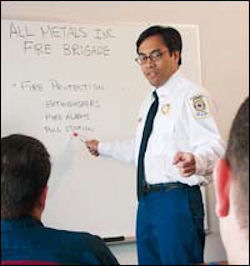Strategies to Manage Stress-Induced Anxiety
To mitigate anxiety and deliver impactful safety training, trainers can adopt a multi-faceted approach combining mental preparation, physical techniques, and practical strategies during the pre-training phase.
Mental Preparation
Shift your mindset to focus on the audience's need for safety knowledge rather than your performance.
- Positive Self-Talk: Remind yourself, "My job is to equip these workers with skills to stay safe. They're rooting for me to succeed." This aligns with the safety training's high-stakes purpose, like preventing the 85,000 annual forklift injuries reported by OSHA.
- Visualization: Picture a successful session where participants actively engage, ask questions, and apply safety protocols. Visualize yourself calmly addressing a question about PPE compliance.
- Reframe Anxiety: Per a 2014 Harvard study, reframe nerves as excitement to boost performance. Say, "I'm excited to teach these life-saving techniques!"
Building the Mental Script
Experienced trainers will tell you that anxiety diminishes with experience. Each time trainers deliver a safety training session, they become more familiar with the content, audience dynamics, and their own delivery style. This process, known as developing a "mental script," allows trainers to internalize key points, anticipate questions, and feel more in control.
Repeated practice accelerates the development of a mental script, reducing anxiety over time. In addition, the following strategies can help building metal scripts:
- Dry Runs: Rehearse the session in the actual training room, practicing key safety demos (e.g., using a fire extinguisher with the PASS technique: Pull, Aim, Squeeze, Sweep).
- Anticipate Questions: Prepare for common safety-related student questions, like "What's the difference between a Class A and Class B fire extinguisher?".
- Incremental Exposure: Start with smaller groups or co-train with a mentor to build confidence before leading solo sessions.
Practice Makes Perfect

Be sure to get ready by practicing your presentation. If you have a training script, read the script. You should conduct at least one "dry run" in front of a mirror, or a friend who can give you some objective feedback. Practice being yourself, not someone else. You'll be able to uncover technical inaccuracies or inconsistencies. You'll learn how to say it better each time.
The idea is that you need to create a "mental script" so that you are not expressing ideas, concepts, principles, or instructions for the first time. Each time you practice, your mental script will improve. If you practice the presentation several times prior to the actual presentation, your presentation will appear more polished.
If you use notes in your presentation, and you don't practice, you'll be glued to them. Nothing looks more unprepared or less sincere than a trainer who reads cards. Learn to express yourself without being dependent on cards. Practicing will allow you to do that. Practicing will also improve your confidence level and that will show.
Knowledge Check Choose the best answer for the question.
2-3. Presenting training gets easier with time because the trainer _____.
You forgot to answer the question!
